Articles by Pierre G. Harmant
Anno Lucis 1839 (2/3)
Eighteen hundred and thirty nine
Anecdotal history of photography by Pierre G. Harmant
Keeper of records of the Société Française de Photographie
II. Rediscovery of known facts
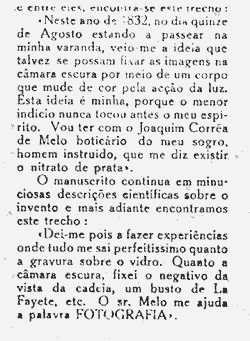
Note in Portuguese on Hercule
'When we were first told of M. Daguerre's invention', says Academician Turpin, 'we could hardly believe it, and we should have dismissed the news as an idle tale if we had not been assured by men of high position and great ability, who had seen for themselves, that it was true' 24.
It may be assumed from this simple quotation that nobody, even in scienfific circles, was really in the know as to what had already been achieved, and so it happened that a number of people rediscovered, to coin a phrase, the recipe for hardboiling eggs.
Among those who were unlucky or, to be more precise, who just missed real success, was a German woman, a painter like Daguerre (a characteristic of the 1839 inventors and photography in general) and we shall give her first place in this detailed revue.
Friederike Wilhelmine von Wunsch was rediscovered by Erich Stenger 25 on going through the secret archives of the Prussian Ministry of External Affairs in Berlin. This woman painter had been resident in Paris for a very long time and, although she had forgotten the language of her ancestors, she thought of offering her discovery to Prussia, for a consideration.
It may be gathered from the documents published by Stenger that she wished the matter to be dealt with through the official channels and approached Von Arnim, the ambassador in Paris, on March 2 at the latest. By this date the attentive newspaper reader would already know of Talbot's process from the letters read by B. J. Biot to the Académie des Sciences, for example, and published in the Reports of the Académie des Sciences 26. Very properly, the ambassador conceived it his duty to inform his superior, the Minister Von Werther. Neither the 'Mémoire' nor the 'Communiqué à la presse' 27 enlightens us as to the method used, for this lady inventor simply claims 'a process permitting portraits to be made in natural size as well as in miniature, such is its speed, and, unlike the results obtained by Talbot and Daguerre, coloured in true tones under the influence of light or of fire' 28. An attractive programme worthy of being presented to H. M. the King of Prussia. Alas! For some still undiscovered reason, the reply was destined never to reach the author of the discovery. Four years later, the famous Alexander von Humboldt (a member of the Académie française des Sciences) who together with his friend Arago was watching the progress being made in the new art, received a letter from Mme von Wunsch which gave rise to an exchange of correspondence with the competent authorities. Von Humboldt inquired into what might have happened and learned that a report had gone astray. Apart from that there is nothing left for us to go on. If it is true, as she insists, that she had improved Daguerre's process (or Talbot's which already suggests a certain confusion) so that she could take coloured snapshots, there can be no doubt that, in spite of the silence maintained by the representatives of her country, she would have spoken about it in other quarters. And if that were really the case, it is difficult to believe that the Prussian state would not have immediately insisted on having specific details of the discovery and publishing the results. Thus, it does not seem rash to conclude with Stenger 'that Germany cannot pride herself on having participated through her in the discovery of photography'.
We are led to a similar conclusion in regard to a certain Liepmann, concerning whom I can discover nothing except (according to a notice inserted in the periodical press) that he was Jewish and a painter. I have not been able to find out what method he used and until more information is forthcoming we will leave him in obscurity. The same may be said of the Brazilian Hercules Florence, whose existence was brought to our notice by M. Nogueira in his 'Almanaque Portuguès de Fotografia, 1958'. This author tells that Hercules Florence produced images on metal plates at Sao Paulo in 1833 but, not knowing how to fix them properly, was obliged to give up his researches' 29.
The sarcastic tone of K. de Roth 30 seems to assess at its true worth the part played by a German clergyman, Hoffmeister (of Nordhausen), in the discovery of photography. In spite of what may be read in the 'Allgemeiner Anzeiger der Deutschen' (1833), this author did nothing but voice a dream, which was shared by any number of his contemporaries, viz. to record the pictures of the camera obscura and to make copies of the results 31. His description is not a scientific one and, like many others, he had confused desire and reality.

Extract from an article by Roth on the 'Hoffmeister Process' (Photographisches Archiv 1863). Reproduction of a text published in 'Allgemeiner Anzeiger der Deutschen'.
A similar fate is probably in store for two figures from Spain and Norway.
'Photo-Revue' of May 17, 1903 32, reports that one may read in an article written by Francesco Alcantara in the 'Madrid Cientifico' that a painter called José Ramos Zapetti had obtained certain results with a camera obscura. 'He could now do without a model or a lay figure and was going to give the whole world the benefit of his discovery, and more especially his companions the artists...' Manifesting the greatest pleasure, Zapetti one day displayed, as proof of his claims, a figure and part of his studio standing out in dark lines on a bright sheet of copper. Two years later Daguerre's invention was made public.
This all took place at Saragossa and, so far as I know, nobody has yet been sufficiently interested to inquire whether or not any traces of this 'discovery' remain. Zapetti dies a short time after his demonstration, it is true, but the close parallel between the means used to obtain pictures by Zapetti and Daguerre is, to say the least, surprising. Is this a hoax on the part of a particularly gifted artist or pure fabrication? We are left to surmise, and can only hope that the Spanish painter revealed his secret before his death.
The case of Hans Thoger Winther seems vastly more genuine. It was recently learnt 33 that this author may have discovered photography on paper during the summer of 1839.
Actually I have been able to discover a work dated 1845 of which he is the author and which appeared in a German translation simultaneously at Leipzig and Hamburg in the same year, 1845. The first paragraph is entitled 'preparation of direct positive prints on paper, invented in the summer of 1839 34. On June 28, 1840, the 'Morgenbladet' 35 published an article in which Winther claimed to have obtained, before the disclosure of August 19, results which were placed on record in a written statement on the preparation of direct positives. Unhappily for the Norwegians, this document has disappeared, and the archivist Ström, who recounts the story 36, thought it might be useful to refer to this document so as to encourage new searches. All we know is that Winther corresponded with leading persons in the contemporary world of science: Berzélius, Oersted and Moser. So let us say with M. Ström that although Winther may not have invented photography, he was as least the first to obtain pictures on paper in Norway...
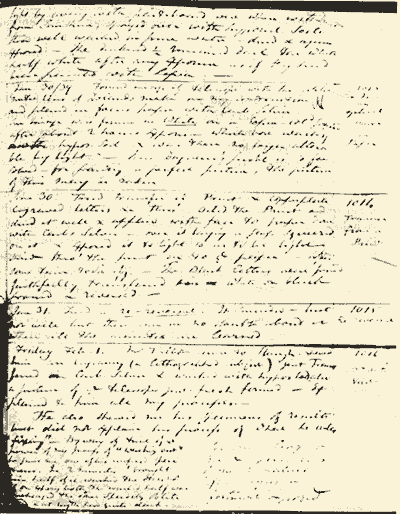
Extract from the laboratory diary of Herschel. (Reproduction by kind permission of the Kodak Museum, London.)
With Professors Karl August von Steinheil and Franz von Kobell we are at last on firmer ground. They are more familiar to us and everyone knows that Steinheil made a great name for himself in the field of photographic optics. However, it is not in this connection that we mention him here.
At the very time the process of Henry Fox Talbot was on the point of being published by the Royal Society in London 37, a promising article on the results obtained by the two professors appeared in the German press 38. The method was actually communicated to the Bavarian Academy of Sciences on April 13, but publication was deferred until July 3.
Silver chloride was precipitated by double decomposition on the surface of a good paper (English) and exposed, still moist, to the light of the sun for five minutes under an engraving. Ammonia was used for fixing. Experiments in the camera obscura had led theses investigators to continue their exposures for hours, keeping the paper constantly moist. What is most important, however, is that we read how the negative thus obtained could be used to reverse the dark and light parts by making the 'negative' the subject and using a new paper prepared in an identical manner. This has a very familiar ring about it and is in fact a description of the printing process soon to be used by Talbot...39.
It is beyond argument that, in this form, the process cannot be compared to the daguerreotype, and it was simply discouragement that led these authors to abandon their attempts at this point. Moreover, I should like to stress that an identical method can be found in a letter of Nicéphore Niépce dated May 16, 1816 40. If the prority is plain, it is only fair to mention that this letter was unpublished until 1867, the date when Fouque's work appeared.
Thus Steinheil and Kobell in Germany and Talbot in England had been working along the same lines without knowing it. They were to follow very different routes, and Kobell, who is less well known than Steinheil, did in fact become the inventor of a galvanographic process which is still used from time to time.
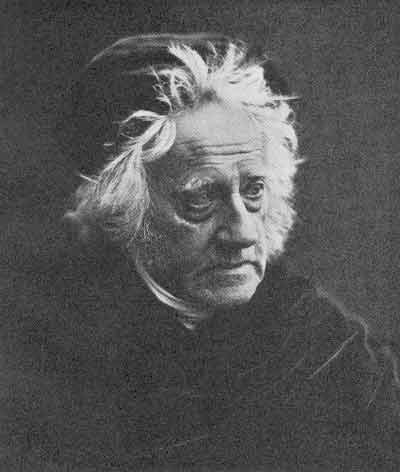
Portrait of Sir W. J. Herschel by Julia Margaret Cameron. (Document reproduced by kind permission of the George Eastman House, Rochester USA.)
In Switzerland an acrid controversy arose between two Berne newspapers. As early as February 2, the 'Schweizer Beobachter' 41 announced in an article by the inventor a process which need not fear comparison (as he modestly put it) with that of Daguerre. He went on to say that, during the past few years, he had been able to have the genuineness of his claim established in scientific circles.
This inventor was Friedrich Gerber, professor at the university of Berne, and he had rediscovered the method of using silver salts to copy subjects of variable opacity. As every man is his own best trumpeter, he took advantage of the stir thus caused to speak of himself and his former works in the highest possible terms.
But he found an anonymous adversary who attacked him in the 'Allgemeine Schweizer Anzeiger' on February 16, showing that Gerber might well have been preceded in the 'new art' by a certain Nips (sic) 42. Now this is extraordinarily interesting, for very few people would remember Niépce, the French papers having as yet said so little about him. So who was this anonymous writer who was so well informed? It must be mentioned in passing that the first public mention of Niépce's work on photography was in the letter from Francis Bauer to the 'Literary Gazette' of February 27, and that it would require a very astute mind to derive this knowledge from the text published in the Reports of the Académie des Sciences of January 7...43.
The irony in which the anonymous article was couched drew a reply from the inventor on February 23 44 expressed in terms which are somewhat unusual from the pen of a university professor but which give us to understand that his pictures were tracing of bird's feathers and enlargements in the solar microscope. It may well be asked, then, in what the actual invention consists, for this is the way in which Talbot began his work, and we shall see that another Englishman, the Rev. J. B. Reade, had also used the solar microscope and silver chloride for his works in 1837. In any case I have been unable to discover how Gerber's pictures were stabilized against the subsequent action of the sun's rays. Like many others, he realized after August 19 that his method had nothing in common with Daguerre's, and Professor Friedrich Gerber remained a veterinary surgeon in Berne, where he died on February 18, 1872. He never made further reference, in public, to his claims.
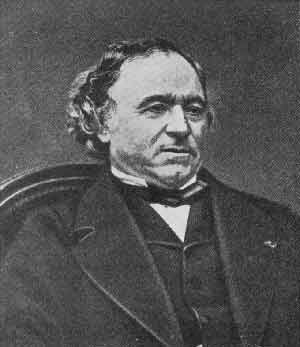
portrait of the chemist J.-B. Dumas.
Another aonymous character who deserves mention, although no further particulars are forthcoming, is the correspondent who signs himself Clericus in a letter to the 'Times ' of February 21, 1839 45.
'Sir, Reading in a newspaper last week that a German had found out M. Daguerre's secret, I was so impressed with that testimony to the possibility of seizing a shadow, that I thought over all the little I knew of light, colours and chemistry; the next day, the 13th inst., I took a piece of writing paper, hastily prepared by myself, placed it behind the lens of a camera obscura made on the spur of the moment, and obtained a satisfactory result, for the trees in front of my house were produced, but not the parts agitated by the wind. Since that, I have obtained, progressively improving, several landscapes which may be called most appositely "lucigraphs". I mention this my humble effort as corroborative of the reality or feasibility of Mr. Daguerre's beautiful discovery; and I can readily conceive that in a very short time the traveller's portmanteau will not be complete without the very portable means of producing a lucigraph at pleasure. Clericus.' (Welney, Wisbeach, Febr. 18, 1839.)

Portrait of the Reverend J. B. Reade. (Document kindly lent by the George Eastman House, Rochester USA.)
There is very little likelihood of 'Clericus' being the Rev. J. B. Reade as might be imagined; the address given precludes such an identification. Moreover, Clericus does not give his method of fixing the pictures. All the same his evidence is valuable in that it shows, to my way ot thinking, that a mind open to scientific things, could, after a little thought, follow the same route as the inventors themselves. This explains the subsequent silence of all those others who appeared on the photographic scene and honestly recongized, not that they were on the wrong track, but that they had arrived at the goal too late.
This was the state of mind in which Samuel F. B. Morse 46 was to find himself when he wrote to his brother (manager of the 'New York Observer') on March 9 as follows:
'You have no doubt heard of the Daguerreotipe (sic), so called after its inventor Mr. Daguerre. It is one of the most beautiful discoveries of the age. I do not know if you remember some experiments I made at New Haven a few years ago when my studio was near to Professor Silliman's, experiments to assure myself that it was possible to fix the image of the camera obscura. I managed to get various degrees of shadow on the paper soaked in a solution of nitrate of silver by means of the various degrees of light; but after finding that light gave shade and shade light, I supposed that the production of a real image was impossible and gave up the attempts. Mr. Daguerre has realized this idea in the most exquisite manner possible...'
I wanted to quote this text at the risk of appearing tedious so as to show that at least one of the 1839 inventors had the courage to recognize that his attempts, which were certainly of interest, could not lead to the realization of everybody's dream. Morse acknowledged in his private correspondence what others were no doubt thinking in the silence of their rooms... The stumbling block was the same in every case: what should be done to stabilize the pictures? And it must be said that, since nobody (or scarcely anybody) yet knew of Daguerre's method 47, each was convinced he had discovered his own by repeating the experiments of the German Schulze, the Frenchman Charles and the Englishmen Wedgwood and Davy... Ignorance of parallel work, mutual mistrust, and a policy of secrecy led the people we have considered here to strike out along trails which had actually been blazed since the Middle Ages. The problem was not to obtain an image but to preserve it, and it is astonishing that nobody, not even Herschel, thought of using the solution which Sir John indicated so clearly in the 'Edingburgh Philosophical Journal', 1819, p. 8 sq.; p. 396 sq., and 1820, p. 154: the use of hyposulphite of soda (sodium thiosulphate).
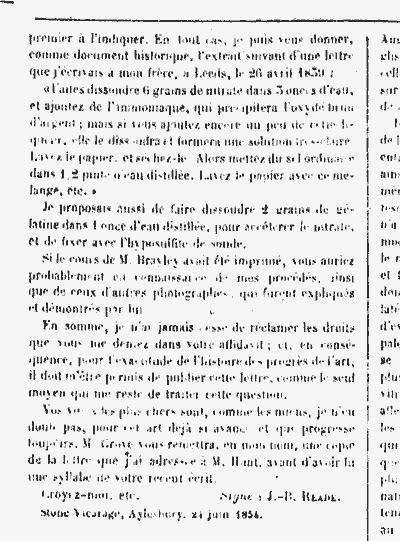
Extract from a letter by J. B. Reade, after a translation published in 'La Lumière', on the occasion of the process Talbot agaisnt Laroche.

From the Report of Raoul-Rochette, published in the 'Moniteur' of 13th November 1839.
If there were any need, this short account would show how essential it is, if anything new is to be invented, to interpret and compare known facts so as to draw new conclusions. Because they failed to do this, the inventors we mentioned must be, not struck off the list, but placed in the margin because the solution they suggested was incomplete and thus not exploitable compared with the achievements which will form the subject of the following section.
- 24. This opinion of an Academician seems rather strange unless he had no knowledge of news in the periodical press. Actually, Daguerre had allowed his results to be published in the 'Journal des Artistes', he had published a maifesto and the 'Gazette de France' alluded to it as far back as January 6, 1839. ▲
- 25. See Erich Stenger: 'Photogr. Korr.' 1929, pp. 285-286, according to documents preserved at that time in the Preussischen Geheim Staatsarchiv in Berlin. ▲
- 26. Reports Ac. Sc. of February 11 and 25, 1839, pp. 207 and 302. ▲
- 27. Published by Stenger (see note 25). The document is dated March 2, 1839. ▲
- 28. 'Die Ergebnisse unserer Landsmännin entstehen derartig schnell, daß sie zum Portraitieren verwendet werden können, selbst bei dem unruhigsten Gesischtsausdruck, von natürlicher Größe bis zu den kleinsten Darstellungen. Und endlich: im Gegensatz zu den Ergebnissen der Herren Talbot und Daguerre sind diejenigen der Dame in wahren Tönen der verschiedenen Gegenstände koloriert. ▲
- 29. Refer to the Portuguese text, note 18. ▲
- 30. See K. de Roth: 'Hat ein deutscher Pfarrer die Photographie erfunden ? " Photogr. Archiv, 1863, pp. 53-57. ▲
- 31. 'Schweizer Beobachter', of Berne, February 26, 1839, No. 25, p. 100. ▲
- 32. 'Les Origines de la Photographie'. Paris, Mendel, p. 25; according to the memoirs of Vincente Poléro; and Eder's Jahrbuch für Photographie, 1905, p. 242; Photogr. Rundschau, 1905, p. 95; Photo-Chronik, 1905, p. 205. ▲
- 33. 'Norsk Fotografisk Tidskrift', No. 9/1958, p. 148; Rolf A. Ström, 'Volund', 1958, pp. 143-147, with ill. ▲
- 34. 'Anviisning til pas trende forkjellige veie at frembringe og fastholde lysbilleder paa papir." Christiania, 1845 ; "Anweisung, auf drei verschiedenen Wegen Lichtbilder hervorzubringen und festzuhalten." Hamburg, Herold, Leipzig, Kummer, 1845. ▲
- 35. See also the 'Morgenbladet' of October 4, 1839, which published an article by Winther dated September 15, revealing that he had obtained direct positive pictures. ▲
- 36. Volund 1958 (Norsk Technisk Museum aorbok) inserted two illustrations taken from the work of 1845. ▲
- 37. His '2nd article' is dated February 22, 1839, but the general method had been presented to the Royal Society as far back as January 30. The report in German appeared at the end of March 1839 in Dingler's Polytechnisches Journal, t. 71, pp. 468 sq. ▲
- 38. The first mention of it I have found goes back to February 1, 1839, in the 'Allgemeiner Anzeiger der Deutschen', but the reader can also consult the 'Gelehrte Anzeigen', published by members of the K. Bayer. Akad. der Wissenschaften, No. 132, of July 3, 1839 (meeting of April 13), amongst other learned journals. See also Stenger: 'Aus der Frühgeschichte der Photographie' (Chap. III). ▲
- 39. (...) 'Um Licht und Schatten auf den rechten Platz zu bringen, werden die erhaltenen Bilder weiter als Objekte für die Camera obscura genommen, in Rahmen gefaßt und mit Sonnenlicht beleuchtet. Zu bemerken ist jedoch, daß die Helligkeitsunterschiede in der Copie nothwendig geringer ausfallen, als in der ursprünglichen Zeichnung, was die Brauchbarkeit diese Methode beschränkt. ▲
- 40. Fouque: 'La Vérité sur l'Invention de la Photographie', p. 78, we find: 'I thought like you, dear friend, that by putting in the optical box a strongly marked negative on a paper dyed with a fugitive colour or covered with the substance I use, the picture would be painted on this paper in its natural colours, for the black parts of the negative, being more opaque, would more or less intercept the passage of the light rays, but there was no effect produced. It is to be presumed that the action of the light is not strong enough; that the paper I use is too thick or, by being covered too much, it forms an insurmountable barrier to the passage of the fluid, for I apply as much as six coatings of white.' ▲
- 41. No. 15 of February 2, 1839, p. 57. The persons to whom Gerber had spoken of his process are quoted: the brothers Volmar, the lithographer Wagner, the 'Dozent' Marti and Carl Vogt, but unfortunately not everybody publishes his 'Memoirs'... ▲
- 42. As far back as February 9, 1839, this sentence, surprising to say the least, could be read n the 'Allgemeine Schweizer Zeitung' (No. 18, p. 71): 'Erst als Daguerres Ruf europäisch geworden sucht Herr Gerber ihm den Ruhm der Entdeckung zu entreißen. ▲
- 43. 'M. Daguerre's invention is the fruit of several years' hard work during which he had as his collaborator his friend the late M. Niépce, of Chalons (sic)-sur-Saône.' It was in these terms that the 'daguerrized' Arago wrote the early history of photography. ▲
- 44. See it the 'Schweizer Beobachter' (No. 24, p. 96) this sentence: 'Dem Publikum erkläre ich hiermit, daß ich unbedingt auf alle Ansprüche von Priorität der Erfindung Verzicht leiste, insofern das Verfahren derjenigen, welche vor 25 Jahren sich mit der neuen Kunst beschäftigt haben, das meinige ist, sonst allerdings nur in Bezug auf das Problem, nicht aber auf das Mittel seiner Lösung, daß ich aber ohne den geringsten Wink von irgend einem Menschen die Erfindung gemacht habe. Ob ich endlich der Einzige bin, der schon vor Jahren, auf dasselbe Prinzip gegründet, vergrößerte Bilder mikroskopischer Gegenstände mittels des Sonnenmikroskops erhalten hat - steht zu erwarten, bisher hat sonst Niemand von dieser folgenreichen Anwendung des Prinzips gesprochen, und Arago würde gewiß dessen erwähnt haben, wenn Daguerre auch nur einen Wink darüber gegeben hätte. ▲
- 45. Extract from the 'Times' of February 21, 1839: 'Reading in a newspaper last week that a German had found out M. Daguerre's secret, I was so impressed with that testimony to the possibility of seizing a shadow, that I thought over all the little I knew of light, colours and chemistry; the next day, the 13st inst., I took a piece of writing paper, hastily prepared by myself, placed it behind the lens of a camera obscura made on the spur of the moment, and obtained a satisfactory result, for the trees in front of my house were produced, but not the parts agitated by the wind. Since that, I have obtained progressively improving, several landscapes, which may be called most appositely "lucigraphes". I mention this my humble effort as corroborative of the rality or feasibility of Mr. Daguerre's beautiful discovery ; and I can readily conceive that in a very short time the traveller's portmanteau will to be complete without the very portable means of producing a lucigraph at pleasure." Clericus. ' (Welney, Wisbeach, Febr. 18.) If further proof were needed, this letter would show that the first photographers were really amateur scientists. ▲
- 46. Letter of Samuel F. B. Morse of March 9, 1839, to his brother. It was not published in the 'New York Observer' until April 20. ▲
- 47. It would seem that Daguerre, being very jealous of his method, did not even speak of it to his own associate Isidore Niépce, if we are to believe what has come down to us of his correspondence, but Arago at least had been let into the secret and had already made some daguerrian pictures as far back as the beginning of 1839. On the other hand, many distinguished visitors could see for themselves that the invention was not a hoax without being initiated into the method by the inventor. ▲